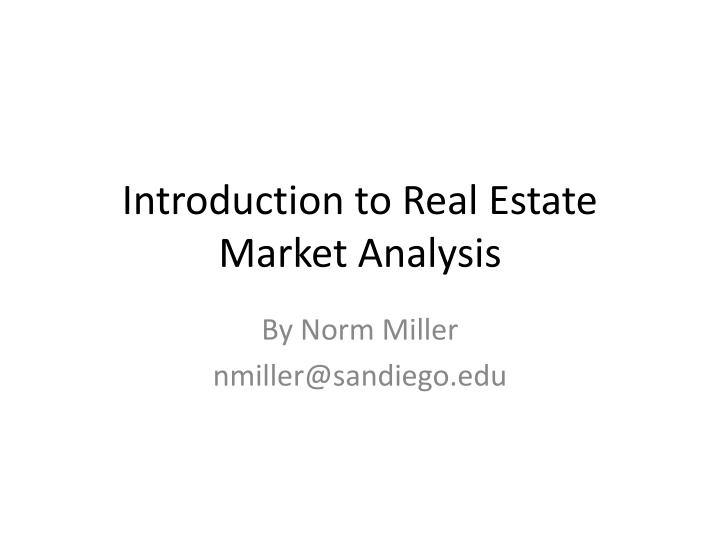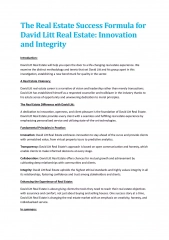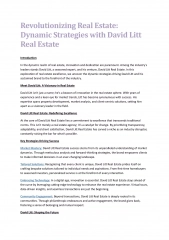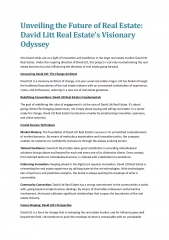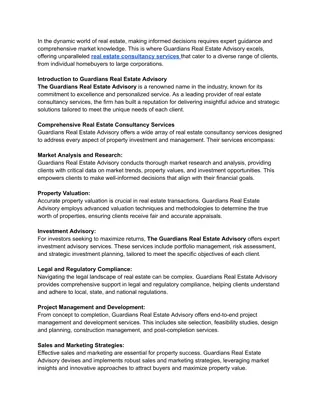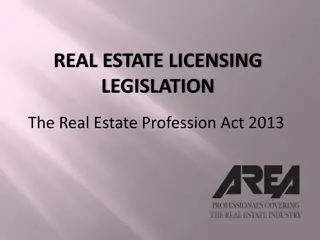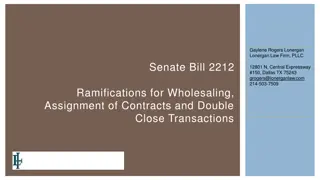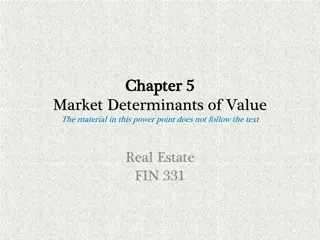Real Estate Market Analysis Essentials
Delve into the intricacies of regulations, supply controls, market dynamics, and land use controls in the real estate industry. Understand the balance between public and private rights and explore local examples of land use controls. Dive into building codes and their impact on construction efficiency and technology development.
Download Presentation

Please find below an Image/Link to download the presentation.
The content on the website is provided AS IS for your information and personal use only. It may not be sold, licensed, or shared on other websites without obtaining consent from the author.If you encounter any issues during the download, it is possible that the publisher has removed the file from their server.
You are allowed to download the files provided on this website for personal or commercial use, subject to the condition that they are used lawfully. All files are the property of their respective owners.
The content on the website is provided AS IS for your information and personal use only. It may not be sold, licensed, or shared on other websites without obtaining consent from the author.
E N D
Presentation Transcript
Introduction to Real Estate Market Analysis By Norm Miller nmiller@sandiego.edu
Content A little time on real estate regulations (Controls on Supply) Real estate cycles and value trends Market Dynamic patterns from a change in demand or supply Submarkets and peering (comps)
Regulations Why do they matter? They tell us if supply can respond or not to a change in demand. They tell us something about the riskiness of new development or retrofitting which affects the required returns or expected profit margins. They are supposed to protect us and provide higher land values when we benefit from good planning.
Regulations The big issue is balancing public versus private rights. Public rights are inherent in the externalities created by real estate uses. Private rights are inherent in the constitution.
Land Use Controls Local Region Specific State Federal
These are not easy questions: Example For several decades property owners around the bleachers at Wrigley field have sold tickets to rooftop seats every game. Last year the total seasonal off site revenue = $27 Million Now the ball field wants to install a JUMBOTRON scoreboard. Do they have the right to do so? It will block off the private roof seats. What are some solutions? Don t property owners have the right to use their own property as they see fit?
Local examples of land use controls Covenants (Subdivision) Design Criteria or Design review committees Zoning Uses (Res, Retail, Industrial, Office, Mixed, etc.) Often in a permitted hierarchy Set backs Density (FAR, floor area ratios) and bonuses Heights permitted Parking requirements Affordable housing requirements Planned Unit Developments, some mixed use Community or City Plans Building Codes and Historic Building Codes
Building Codes Type of material requirements (function of construction types and heights) Types of access and fire escapes Inspection process Studs then electric, inspection, plumbing, inspection before the next step Inhibits the development of advanced building technology and greater efficiencies, especially modular units. Ex: Sometimes inspectors want features that contradict each other, fire inspector versus elevator inspector. Some agencies coordinate but this is rare.
Local Land Use Regulation Process: Political in nature, not economic Neighbors can rally for or against. NIMBY sm is rampant today and somewhat cultural. Local representatives matter (e.g. Chicago, Alderman must know before a new proposal goes in or it is sunk!) Hearings and appeals at the city or county level or planning agency are typical.
Regional Example California Coastal Commission that controls 3 to 5 miles in from the coast and serves to protect the environment Impact: They can stop any development, impose lease requirements they see as beneficial and require extractions of many sorts, i.e. public lands, parks, or more.
State and City Example California Green Building Code California CEQA (California Environmental Quality Assessment) Seattle Green Building Code What the market prefers? Standardization Criteria known in advance Trade off when possible different ways to achieve desired results.
The benefits of fully entitled land How do land prices vary by readiness to start development? Raw Zoning OK but need to get through 4 or 5 agencies? How much is time worth? Risk of no approval for several years?
Federal Level Controls Environmental Policy Act (1969) http://www.epa.gov/lawsregs/laws/nepa.html and CERCLA 1980 (Superfund) http://www.epa.gov/lawsregs/laws/cercla.html Endangered Species Act of 1973 http://www.epa.gov/lawsregs/laws/esa.html Water 1972 http://www.epa.gov/lawsregs/laws/cwa.html Wetlands 1977 Clean Air Act 1970 with many amendments, see http://www.epa.gov/air/caa/ Enforcement via funding penalties. Note California tried to pass it s own related bill for cars and emissions. Not to mention the Highway Beautification Act of 1965
CERCLA CERCLA: Comprehensive Environmental Response, Compensation, and Liability Act of 1980 The primary federal statute that may result in personal liability from the acquisition, ownership or operation of real property Also referred to as the Superfund , it sets forth a complex regulatory scheme to identify, investigate, analyze and remediate property contaminated with hazardous waste Who is liable?: Current/ past owners, generators/ possessors and transporters of hazardous substances.
CERCLA Impact As a result of CERCLA, there are three defined stages of mandated reports and actions to try and avoid liability for clean up costs of a contaminated site, or investigate the extent/ cost of actual clean up: Phase 1: To determine whether there is evidence of past or current environmental problems on the subject site. Phase 1 is required on all commercial property Note: Brownfields are any property with a previous use of almost any kind, especially one with contamination possibilities using stored liquids. Phase 2: To test and verify the extent of the actual contamination Phase 3: Actual action plan that usually includes remedial cleanup efforts
Again: What are the impact of regulations? A shift in demand will have much more price impact in a supply constrained market. San Francisco Supply curve San Antonio TX Supply curve
. the impact of regulations? A shift in demand will have much more price impact in a supply constrained market. San Francisco Supply curve San Antonio TX Supply curve Q
the impact of regulations? A shift in demand will have much more price impact in a supply constrained market. San Francisco Supply curve San Antonio TX Supply curve Q
Or in some cases To totally prevent a development at all and shift development to other markets. Ex: lack of affordable micro unit living units pushes lower wage workers to commute further or live in different geographic markets or bundle up with relatives.
Moving towards dynamics: Short Term to Long Run We are seldom in equilibrium but often moving towards it. We cycle around it.
Why do we have cycles in rents and prices? Rent cycles Leases of several years Lumpy nature of leasing where a large building comes on line in a given quarter Poor expiration management Leasing agents often propose similar terms without regard to duration risk of expirations. Correlation with economic and employment cycles
New York City 5 Year Rental Rate Rollovers $55 $23.63 $0.46 $50 $45 $15.46 $40 $3.14 $35 $30 $10.11 $25 $18.33 $20 1994 1995 1996 1997 1998 1999 2000 2001 2002 2003 2004
Washington DC 5 Year Rental Rate Rollovers $2.50 $33 $10.25 $31 $29 $7.92 $27 $2.29 $25 $23 $5.85 $21 $19 $9.05 $17 $15 1994 1995 1996 1997 1998 1999 2000 2001 2002 2003 2004
San Francisco 5 Year Rental Rate Rollovers $4.81 $55 $10.28 $50 $45 $40 $35 $30 $25 $20 $6.59 $15 1997 1998 1999 2000 2001 2002 2003 2004
We also have price cycles: Why? We over shoot and under shoot price momentums. We have cycles in capital access.
We need to Monitor and Forecast Both Rent & Prices Keep in mind: Present values are based on future rents. We need to try and look forward but we usually do this looking back (history). All positive or negative factors are considered while making these projections. However, there is disagreement over the exact rental rate trend. This creates opportunities for people to make a bet on the future trends and in some cases to create value. Rents and prices depend on demand and supply, and the elasticity of supply, hence both need to be analyzed to see trends.
Market Dynamics: Demand and Supply again
Market Dynamics: Searching for Equilibriums Supply and Demand are bought together by rent or price Economic principles to understand real estate housing markets: 1. The short run equilibrium mechanism in the rental market are changes in vacancy levels, followed by rent levels. 2. The long run equilibrating mechanisms in the rental market are adjustments to the supply 3. In the short run supply tends to be very inelastic
Searching for Equilibriums (Contd.) Economic principles to understand real estate markets (Contd.): 4. Developers expect a minimum rate of return in order to induce new investment in production of new or retrofit property. If this can t be achieved we will not see new supply. Note that sometimes some developers are more creative than others and see new and better uses that others don t see. Keep in mind that markets operate in submarkets and there are innumerable submarkets, defined in terms of geographical area, quality, size range, or other features typically important to a group of potential renters or buyers. 5. Negative supply adjustments take time. Property wears out slowly. We see less maintenance in a below market return property.
Examples of Demand/ Supply Changes for Multifamily Demand Increase in local employment increase demand for housing Decrease in average birthrate decrease (increase) demand for larger (smaller) units Supply Construction of public buildings/ roads that take out existing stock (-) Natural disasters tornadoes, floods, hurricanes (-) Apartment complex condemned as uninhabitable (-) Housing units refurbished (+) New housing construction (+)
Patterns of Possible Market Changes Two general processes which bring a market back to long run equilibrium after a change in demand or supply: 1.Demand increases or supply is reduced 2.Demand is reduced or supply increases beyond equilibrium levels
Demand Increase or Supply Reduction Vacancy rates decline, possibly to zero (waiting lists may even occur) Rents increase Rates of return increase. New construction occurs Eventually rates of return declines, which reduces the construction rates D2 S1 Rent S2 D1 1st 2nd Supply Q1 Q2
Supply Increases (above normal) and Over-shoots Demand Vacancy rates increase Rents decline Rates of return decline Maintenance and repair my decline (increasing rate of deterioration) No new construction occurs Eventually, properties will deteriorate to lower submarket levels, reducing the supply of the affected submarket, until rents and rates of returns come back to equilibrium
Supply Over-shoots Demand S1 1st Rent S2 D1 2nd 1st 2nd Supply Q1 And Q3 Q2 A sudden and permanent decrease in demand caused by a large job lay off in the local market could take several years to reach equilibrium
The Space Marketagain but at what level of geography? Supply: Demand: Property Owners (Landlords) Property Users (Tenants) MARKET Rents (e.g.$/SF) Occupancy
Segmentation in the Space Market or think of submarkets and peering What properties would be compared by tenants? Buyers? How large a geographic area? Criteria? Age Location Building Rating System Tenant mix? Other?
Keep in mind supply is lumpy and that affects the reaction of the market Adding space is lumpy, so we may have 4 million sq ft of empty Class A space but no space over 150,000 sq ft contiguous therefore the large user can t find what they want even with 10% vacant space! Is Industrial lumpy? Multifamily? Retail?
Most differences in prices and values are the result of land price differences. This is why we see..
Prices for a typical (same) median house: 2000 SF, 3BR/2B, City Price Index Cleveland, OH $126,000 .58 Cincinnati $138,000 .64 Dallas, TX $146,000 .67 Atlanta, GA $168,000 .77 Chicago, IL (Schaumburg) $263,000 1.21 Chicago, IL (Lincoln Pk) $409,000 1.88 Los Angeles, CA $563,000 2.59 San Diego, CA $607,000 2.79 San Francisco, CA (city) $721,000 3.32 New York City $1,422,000 6.55 New York City is 10-times Cincinnati San Francisco is almost 6-times Cleveland: Location, location, location Data: Collateral Analytics 2012
